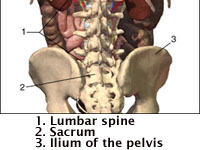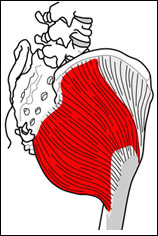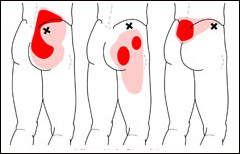This is a series on low back pain. If you missed the summary of causes, go back to Part 1

When a patient comes into my Neuromuscular Therapy center near Boston with complaints of low back pain, they often mean the portion across the sacrum on either side of the back of the hips and top of the buttock. Low back pain is often caused by the gluteus maximus and medius muscles that attach here. Pain can also be caused by the ligaments and the fibrous connective tissue (called fascia) that connect the bones of the lower spine and pelvis or by muscles whose fibers cross over the bony line. In addition there are Trigger Points referring pain across the junctions in both directions.
The last post discussed the role of the erector spinae in causing low back pain. The tendons of the iliocostalis have fibers that are continuous with the tendons of the gluteus maximus and affect both together. The lumbar fascia connects the hip bone (ilium) to the ribs and vertebrae and to muscles in the lumbar region producing both muscle and tendon pain. Just over the crest of the ilium is the attachment of the gluteus medius, running all the way from the front angle of the hip bone to the back of the curve where it tucks under the upper edge of the gluteus maximus. Because of their close proximity, movement of either the glutes or the lumbar muscles affects the other group so pain can develop in both.

 You can’t stand up straight or bend over without using the gluteus maximus. That should tell you a lot about low back pain caused by this muscle since so much injury is caused by overload in forward-bending positions. Overuse of the muscles can cause strain of the ligaments that hold the bones together as well as compression of the sacroiliac joint to which the gluteus maximus attaches. Whenever a muscle crosses over a joint, it can close that space when it tightens up. The compression causes nerves to fire off. When there is too much pressure for too long the joint becomes irritated, unhealthy and painful. Healing comes from loosening the muscle to take the pressure off the joint. So not only can the gluteus maximus cause low back pain locally in the muscle, it can also cause the joint pain that results from muscle tension.
You can’t stand up straight or bend over without using the gluteus maximus. That should tell you a lot about low back pain caused by this muscle since so much injury is caused by overload in forward-bending positions. Overuse of the muscles can cause strain of the ligaments that hold the bones together as well as compression of the sacroiliac joint to which the gluteus maximus attaches. Whenever a muscle crosses over a joint, it can close that space when it tightens up. The compression causes nerves to fire off. When there is too much pressure for too long the joint becomes irritated, unhealthy and painful. Healing comes from loosening the muscle to take the pressure off the joint. So not only can the gluteus maximus cause low back pain locally in the muscle, it can also cause the joint pain that results from muscle tension.
 Trigger Points in both the gluteus maximus and medius are very important to me as a Neuromuscular Therapist. Pain from gluteus maximus Trigger Points refers into the buttock primarily and can refer into the sacroiliac joint (between the sacrum and the ilium of the pelvis, see above). Low back ache has also been reported.
Trigger Points in both the gluteus maximus and medius are very important to me as a Neuromuscular Therapist. Pain from gluteus maximus Trigger Points refers into the buttock primarily and can refer into the sacroiliac joint (between the sacrum and the ilium of the pelvis, see above). Low back ache has also been reported.
 Trigger Points from the gluteus medius are a primary cause of low back pain. Referral patterns form an arc along the top of the hip bone, down into the buttock and across the sacrum.
Trigger Points from the gluteus medius are a primary cause of low back pain. Referral patterns form an arc along the top of the hip bone, down into the buttock and across the sacrum.
Deep to the gluteus maximus is the piriformis. This little muscle packs a whallop in terms of pain. Read the next post for more information.
I found your article very informative. I’ve been suffering from this pain for a couple of months now. I had couple of physio sessions and pain eased a lot. I started running again and working out and now seem to be back to square one. I’m going back to physio tomorrow but I really hope I can start exercising again very soon. Thanks
jacqueline
In your Physical Therapy appointments make sure they are paying attention to stretching the muscles appropriately and treating them manually. Exercise can make hyperactive muscles painful again. Look at my information on Active Isolated Stretching for a more effective way to stretch. Self-treating by putting pressure on places that hurt and holding the pressure until the muscles begin to soften will help. Try lying on a foam roller or on a tennis or lacrosse ball to be more specific.